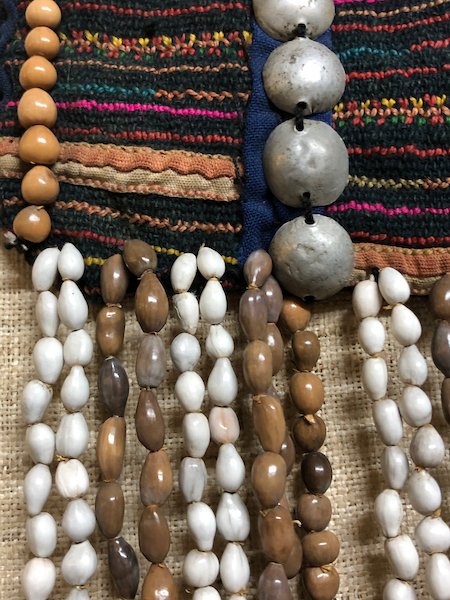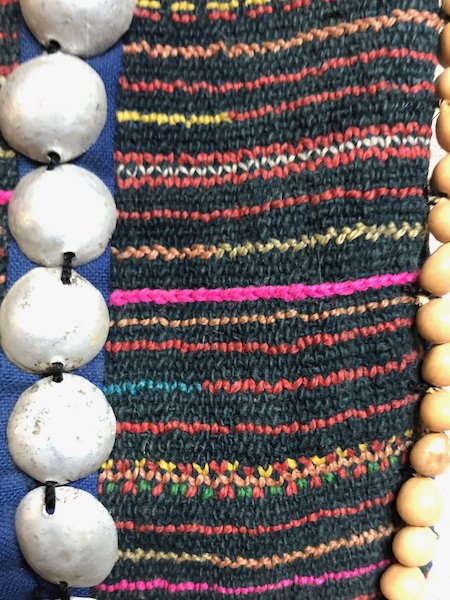The Akha pieces shown here come from northeast Thailand, where Akha people have lived for generations, many of them originally migrating from southern China. The jacket above is the finest piece I've encountered. It was hanging high in a small shop near Mae Hong San, an anomaly in a general store where I was buying food or something else. I started admiring it, and the young shopkeeper offered to take it down. She told me her grandmother made it, before her family came from China. I didn't find out how long ago that was, but her grandmother was no longer living. She said that no one does embroidery that well anymore, and I could easily believe her, based on other samples I'd seen in the Chiang Mai night market and as imports in the US. Each cross of her cross stitch work is one millimeter square.
There was no question about whether I wanted to buy it, but I asked the young woman if she was sure she wanted to sell such a special piece. While I'm certainly treating it with care and respect, and hope to share it in educational ways, it is a shame that people feel compelled to sell off such treasures of their families' history. Since this was 15 years ago, I was not as thorough as I should have been with gathering information, and I know less about it than I would like.
The designs are complex, and the embroidery astounding in its intricacy, but what impresses me the most when examining the jacket closely is how well executed every last detail is. Every seam in the jacket is hand sewn with minute stitches, and there are bindings and pipings (as in the detail above,) and embellishments on every join.
The jacket is in excellent condition, as if new, although it must be at least 30 years old by now. I'm guessing it was the type of thing that is made for very infrequent wear, and was mainly in storage before it was sold.
Another Akha textile I have is a small pouch embellished with metal and seeds known as ‘Job’s tears’. This name seems to refer to a variety of shiny seeds that are used in textiles in the region of Laos and Thailand. I don’t know what they’re called in local languages, or how many different kinds are recognized, but the ones on this pouch are the most tear-shaped. The pouch is embroidered with tiny counted stitch designs and appliquéd strips.
Akha women wear knee-length skirts, and small bags or panels like this, with beaded fringe or buttons to give them weight, are worn in front. They hold down the skirt in front of her crotch as a woman moves or squats. If constructed as a pouch, they are also like a tie-on pocket, handy for carrying small things.
The use of seed beads was featured in a gallery exhibit at the Traditional Arts and Ethnology Centre of Laos while I was in Luang Prabang in 2016. The exhibit was curated by Dr Yukino Ochiai, and included an impressive range of textiles from tribal peoples of Laos, Thailand, Myanmar, and India.
An elaborate Akha headdress from the Seeds of Culture exhibit, TAEC 2016
Handwoven clothing from Myanmar, left, and Nagaland, India, right, includes seed bead embellishment. The lush red and black Nagaland cloth is woven using backstrap looms, or ‘loin looms’ as they are known in that region.




